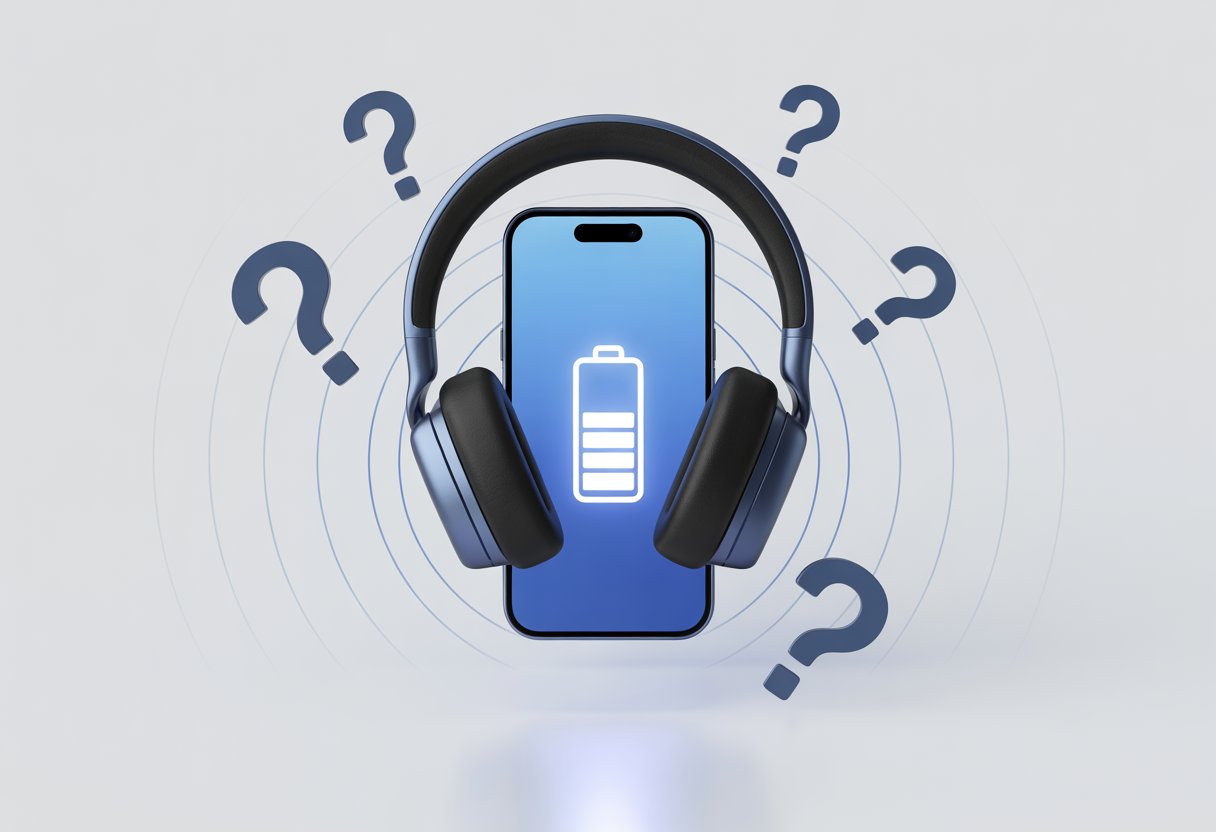Let’s be real—most of us wish our Bluetooth headphones would just be more helpful. We’re jamming out, then boom—silence, because the battery died with no warning at all.
The big reason our Bluetooth headphones don’t show battery level? Not every device or headphone supports the Bluetooth standard for reporting battery levels. Some headphones just keep that info to themselves, and we’re left guessing.

Ever stared at your phone, hoping the battery number would magically appear? Yeah, same. Even if our phone supports battery status, sometimes the headphones just ignore it.
Other times, we might be missing a setting or an update—or maybe the device and software just refuse to get along. It’s like the worst group project ever.
Let’s poke around and see how battery reporting works, why some headphones actually tell us, and what we can try to avoid that sudden quiet. Nobody enjoys a surprise intermission.
How Bluetooth Headphones Report Battery Level
Let’s be honest, knowing when our Bluetooth headphones are about to quit is the difference between a good day and a sudden, awkward silence. Bluetooth gadgets spill their secrets with battery bars, blinking lights, and sometimes those dramatic voice warnings.
Battery Indicator Methods
Our headphones have a few ways to announce their battery life. The most common is the on-screen battery indicator that pops up on our phone or computer.
On some devices, we might catch a battery icon in the system tray or notification area. If you’re on Windows, you can use special tools like Bluetooth Battery Monitor to keep tabs on everything at once.
But not every headphone is chatty. Some don’t support the Bluetooth standard needed to share battery info with our phones or computers.
If the Bluetooth GATT Battery Service isn’t there, the system has no clue how much juice is left. In these cases, we’re just guessing or keeping a charger close.
Role of Bluetooth Connection
Bluetooth does more than just play music—it’s also the main gossip channel for battery updates. When a headphone pairs with our device, it tries to send battery data—if both sides speak the same “language” (protocol).
If either the headphones or our phone don’t get the message, we’re out of luck. Sometimes the Bluetooth drivers or device support mess things up.
A device might shout “Battery Low!” at 80% because the data didn’t sync up. It feels like our headphones make up their own rules for when to charge.
Some platforms, like macOS, show the battery in Control Center. Others, like iOS, use a battery widget for a quick peek.
Still, it all depends on Bluetooth—and whether our gear is in the mood to share.
Voice Prompt and Product Lights
When our screens let us down, headphones get dramatic. Many headphones offer voice prompts that blurt out “Battery Low!” right in the middle of a song.
Sometimes it helps, sometimes it’s just awkward. Product lights try to warn us, too.
We see blinking red lights, color changes, or sad little flashes when the battery drops. The light show is different for every brand, but red is never a good sign in headphone world.
We have to pay attention to these signals or risk silent commutes and missed calls.
Even without a battery bar, at least lights and voices try to get our attention—ready or not.
Common Reasons Battery Level Is Not Displayed
Bluetooth headphones and our phones are supposed to work together to show battery percentage, but sometimes they act like stubborn roommates who just won’t talk. Why do we wind up guessing if it’s time to plug in or just risk it?
Headphone Model Limitations
Let’s face it—not all headphones are created equal. Some wireless headphones just don’t support the Bluetooth features needed to show battery level.
If our headphones don’t have the GATT Battery Service, our phone can’t read their battery info, even if it tries. Here’s a quick checklist of possible model limitations:
- Older models usually don’t support battery reporting.
- Budget headphones sometimes skip this feature to save money.
- Even big brands might leave out battery reporting on cheaper versions.
If our headphones didn’t brag about “smart” battery displays in the ads or manual, we’re probably stuck with a blinking red light as our only warning. Want more insight? Check out this Reddit thread.
Compatibility With Mobile Devices
Sometimes the problem isn’t our headphones—it’s our phone (or tablet, or computer). Different brands and operating systems handle Bluetooth battery data in their own weird ways.
On iPhones, battery status might show up near the top right, but only for certain devices. Android users? We get to play “Does my phone support this?” Not all Android versions show headphone battery levels.
Some need extra settings turned on, like the “Calls” permission, before we see the battery percentage. If nothing works, maybe our phone just doesn’t support it yet.
For more details, this Android StackExchange post is pretty helpful.
Outdated Firmware or Software
Sometimes, our headphones or phone just need an update. Outdated firmware on headphones can block battery communication, and the same goes for our phone’s operating system.
If we miss enough updates, these gadgets won’t play nice together. Keep your devices updated!
Check for:
- Headphone firmware updates (usually in the brand’s app)
- System updates for your phone or tablet
- Bluetooth driver or app updates if you’re on a computer
If our gadgets ignore each other’s battery status, missed updates could be the reason. Been a while since the last update? Give your devices some upgrade love.
If you want to see what can go wrong with battery info and software, visit this Microsoft community topic.
Troubleshooting Missing Battery Indicators
Sometimes we connect our Bluetooth headphones, expecting a battery indicator to pop up, but… nothing. It’s easy to wonder if our headphones are hiding secrets.
Let’s try some common fixes and see if we can coax that battery level out of hiding.
Checking Battery Light and Product Lights
Some headphones keep things simple (or mysterious) with a battery light instead of a digital indicator. We should check if our headphones have a tiny LED that glows, blinks, or changes color when turned on, charging, or running low.
Here’s a quick cheat sheet:
| Light Color | Status |
|---|---|
| Green | Fully charged |
| Orange/Yellow | Partly charged |
| Red | Low battery |
| Flashing | Needs charging or pairing |
Sometimes these lights are so tiny, they’re easy to miss. Grab the manual or search online for what your device’s light colors mean.
If we see no lights when pressing any button, the battery might be totally dead or there’s a bigger problem.
Using Manufacturer Apps Like the bose app
A lot of headphones, especially the fancier ones, have their own apps. For example, if we rock Bose headphones, the Bose app can show the battery percentage, let us tweak settings, and even push out updates.
Here’s what to do:
- Download the app for your headphone brand.
- Connect your headphones through the app.
- Check if it displays a battery indicator.
Sometimes the battery display on the phone disappears, but the manufacturer’s app brings it back. If our headphones don’t even show up in the app, make sure Bluetooth is on and the headphones are compatible.
Not all headphones play nice with every phone, as people mention on the Microsoft Community.
Resetting Your Headphones
If nothing works, try a good old reset. It’s like sending our headphones to boot camp—they often come back working better, and maybe, just maybe, the battery indicator will show up.
To reset, usually we hold down power or a combo of buttons for a few seconds. The method depends on the brand, so check the manual or search online.
After a reset, reconnect and see if the battery level appears. Sometimes headphones just need a fresh start, like us on a Monday.
If nothing changes, our headphones might not support showing battery info at all. Some folks on Reddit mention this too.
Time to decide: are we okay guessing the charge, or do we want to try a different pair?
Alternative Ways To Monitor Remaining Battery Charge
Not all Bluetooth headphones show their battery charge on our devices. But we’re not totally in the dark.
We can use voice prompts, blinking lights, and a little guessing to avoid that dreaded low charge shutdown.
Listening for Low Charge Voice Prompts
We’ve all been startled by that robotic “Battery low!” while listening to music. Most headphones include some sort of voice prompt when the battery’s running out.
Sometimes it’s a beep, sometimes a voice, sometimes a weird sound that’s way too dramatic. If we’re lucky, these prompts kick in with enough time to plug in before everything goes silent.
Some headphones nag us every few minutes until we finally charge. It’s not the most precise method, but these reminders do help keep us out of silent mode.
To get the most out of this, we should actually pay attention the first time and check which battery warnings our headphones use. Many brands mix sounds and voices, so reading the manual (yeah, it’s boring) can give us a heads-up on what to expect.
Observing LED Alerts
If we prefer blinking lights over talking headphones, plenty of models use LED indicators for battery charge. Usually, we see a solid green for fully charged, yellow or orange for halfway, and a blinking red when the battery is low—like our own little disco ball of doom.
Sometimes the flashing pattern changes as the charge drops:
- Slow blink: Medium battery
- Fast blink: About to die
Remember, the color and blinking style might be totally different depending on the brand. If we ever mistake the LED for a police siren, it’s probably time to check what our model’s lights mean or look up the manufacturer instructions online.
Estimating Battery Life Manually
If all else fails, we can always fall back on the good old guessing game. Most Bluetooth headphones tell us in the manual how many hours they last on a full charge.
Say we’ve listened for two hours and the manual claims six hours total. We can figure we’ve got about four hours left—simple math, though it feels a bit risky sometimes.
It helps to jot down start and stop times, either on paper or our phone. That way, we don’t have to trust our memory (which, let’s be honest, isn’t always reliable).
It’s not exactly scientific, but it’s better than getting cut off mid-song during a Zoom call. This method works best for those who actually remember to log things and charge overnight—not that many of us do.
Device and Platform Differences in Battery Level Support
Bluetooth headphones and their battery level displays love to keep us guessing. Whether we’re on our phones, working at our computers, or chilling with a home soundbar, battery level support can be all over the place.
Android vs. iOS Support
Let’s be real, Android and iOS don’t always get along. Most Bluetooth headphones should show battery level on both, but in practice, it’s a mixed bag.
On iOS, battery levels for supported headphones usually show up in the status bar, Control Center, or the Bluetooth menu. Apple really wants us to know when the music’s about to stop.
If our headphones support Apple’s battery reporting, the level just pops up—sometimes almost magically.
Android users get a more unpredictable experience. Some brands and models show battery levels at the top of the screen, others make us use a special app, and a few just don’t show anything at all.
Android’s challenge is that not every device uses the Bluetooth battery reporting standard, so it depends on both our phone and the headphones. If the headset doesn’t send the right info, Android can’t help.
For the technical details, check out how the Bluetooth Standard for reporting Battery Levels affects things.
Laptop and Desktop Display Limitations
Moving to laptops or desktops, things get even trickier. Windows, especially newer versions, have improved at showing battery levels for some Bluetooth devices.
We might see percentages or battery bars in the Bluetooth settings or system tray, but only if our headphones and drivers play nice. For a step-by-step guide, these Microsoft instructions can help.
MacOS users usually spot the battery level in the Bluetooth menu—if the headphones are compatible. Sometimes, though, the device just won’t show up, even for Apple.
Some older or less compatible headphones don’t send battery details at all. In that case, neither Windows nor Mac can show us anything.
If our headphones aren’t talking, the computer can’t listen. That’s just how it goes.
Home Cinema and Soundbars
Let’s be honest, home cinema systems and soundbars don’t care much about battery percentages. These devices are usually plugged in, or if they’re wireless, they often skip the battery indicator altogether.
When we connect Bluetooth headphones to a soundbar or home cinema, there’s usually no way to check the headphone’s battery on the screen or remote. The soundbar’s busy blasting explosions, not showing battery stats.
We have to rely on our headphones’ lights, beeps, or whatever cryptic signals they use. Sometimes there’s an app, but usually, we’re left guessing—right up until the headphones beep loudly in the middle of our favorite scene.
For more on typical issues when the battery level doesn’t display on the status bar, you can check advice for earbuds, which usually applies to other home devices too.
When to Seek Product Support
Sometimes, our Bluetooth headphones just don’t want to reveal their battery secrets. If we’ve tried all the basic fixes and still can’t see the battery level, it might be time to get help or look into a warranty claim.
Warranty and Replacement Options
Let’s face it—sometimes our gadgets quit before we do. If our Bluetooth headphones are still under warranty, we might get a replacement or repair for free.
Most companies offer at least a one-year warranty, but it’s worth checking the fine print unless we’re feeling lucky.
If we bought our headphones recently and the battery display stopped working, the issue might count as a manufacturer defect. Here’s a quick checklist:
- Check the purchase date and warranty period.
- Find proof of purchase (invoice, email, or possibly a selfie with the box—okay, maybe not that last one).
- Look up the company’s warranty process on their website.
Some brands offer full replacements, while others want us to send the headphones in for repair. If possible, avoid companies whose “customer help” line is just someone pretending to type loudly.
Contacting Technical Support
If we’re tired of wondering whether our headphones will last through another Taylor Swift album, it’s time to contact technical support.
Most brands have a phone number, live chat, or email for product support. We should give them all the details: headphone model, purchase date, and maybe how many times we tried reconnecting to Bluetooth.
Being polite actually helps—no need to go full angry emoji. Sometimes, re-pairing instructions or a firmware update from tech support can fix things.
Mention any weird LED lights, beeps, or odd signals the headphones use. Check for the right support contacts on the company’s website or in the manual.
For products like these, it’s usually worth a shot before tossing the headphones in the “mystery junk drawer.”
Extending Bluetooth Headphones Battery Life
Keeping Bluetooth headphones going longer feels like a never-ending quest. Let’s break down some smarter charging routines and spot those sneaky features that drain battery life.
Charging Habits for Longevity
We all love charging to 100%, but leaving headphones plugged in for hours is like letting them sunbathe too long—eventually, it’s not good for them.
The best move is to unplug once they reach full charge. Charging overnight is convenient, but over time it can hurt battery health.
If our headphones sit unused most of the week, it’s better to top them up once they drop below 30% instead of charging constantly.
It’s also smart not to let the battery die completely. Lithium-ion batteries—what most headphones use—prefer to stay between 20%-80%.
Charging with the original cable and charger is always safest. Cheap chargers? Not worth the risk.
Slow and steady charging usually wins the battery life race.
Managing Energy-Draining Features
Bluetooth headphones come loaded with features—noise cancellation, LED lights, voice assistants. These features eat up battery life fast.
If we don’t need them, turning them off means more music and fewer surprise shutdowns.
Noise cancelling and transparency modes drain the battery the most. Turning off noise cancellation can make a big difference.
Built-in lights look cool but are rarely necessary unless we’re DJing in a cave. Keeping the Bluetooth connection range short helps too, since the headphones use less power searching for a signal.
Lowering the volume a bit can add more minutes to our listening time. We should check the headphone app or settings to disable anything extra.
With a few tweaks, we can stretch battery life and get more tunes for our buck.
Other Battery-Reporting Audio Devices
Some gadgets make checking battery levels easy. Others? Not so much. It depends on the design, the tech, and maybe the manufacturer’s sense of humor.
True Wireless Earbuds
Let’s be honest—true wireless earbuds love to keep us guessing about battery life. Some models show battery info right on our phone’s lock screen or in Bluetooth settings.
If we’re lucky, we’ll see a percentage for each bud, not just a vague “medium” or “low.” Some premium earbuds even have a companion app that shows exact levels, charging case status, and maybe reminds us how often we lose the left one.
Here’s a quick table of common notification options:
| Device Type | Shown on Phone | App Required | Case Battery |
|---|---|---|---|
| Budget Earbuds | Yes* | No | No |
| Popular Brands | Yes | Sometimes | Yes/No* |
| High-End Models | Detailed | Yes | Yes |
*Not all models support these—some just want us to guess.
Speakers and Speaker Accessories
Bluetooth speakers can be helpful or totally mysterious. Some show a battery icon in Bluetooth settings, while others just blink a light, leaving us to guess how long we have left.
If a speaker comes with a phone app, battery details might show up there too.
Speaker accessories, like docks or smart assistants, sometimes display battery status on their main screen or app.
The catch? We usually have to dig through menus or tap more buttons than it took to set the whole thing up.
We recommend keeping a charger nearby, just in case our playlist outlasts the battery.
Wearables: Fitness and Audio
Wearables really go all out, don’t they? Smartwatches, fitness trackers, and audio glasses usually flash battery levels right on their own tiny screens.
You’ll also spot them in your connected device’s notification area. Some even toss in charge reminders, so you don’t have to risk the shame of your headset dying in the middle of a call.
Audio-focused wearables like neckband headphones often use a physical battery light or a quick voice prompt. And if you want more details, just check their apps—battery percentages pop up, sometimes with a cheeky low-battery warning.
Okay, wearable, we get it. Time to plug you in before that next workout.
- Why do my Bluetooth headphones not show battery level? The Mystery of the Invisible Juice! - October 15, 2025
- Why do my Bluetooth headphones not work with my drone remote? The Sky’s Not Ready for Your Playlist - October 14, 2025
- Why is my fitness tracker losing data? Blame Gremlins, Sweat, or Just Forgetful Tech - October 14, 2025






